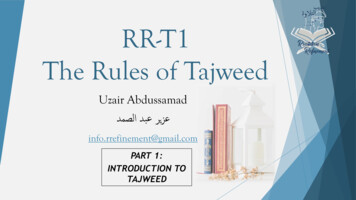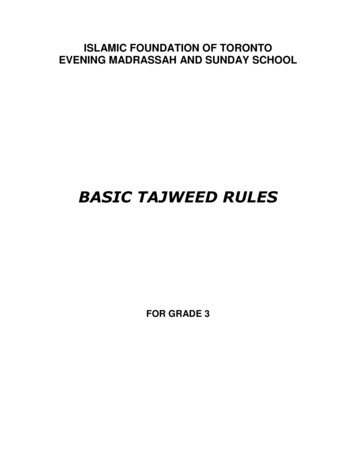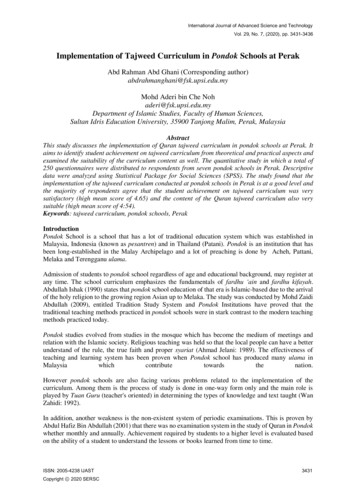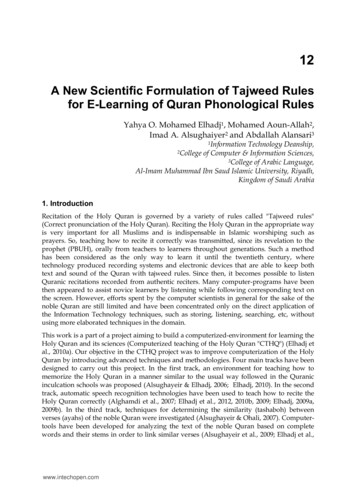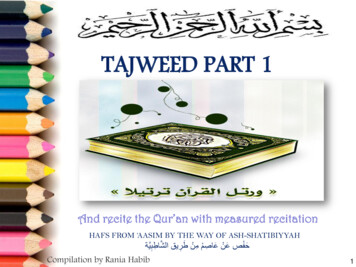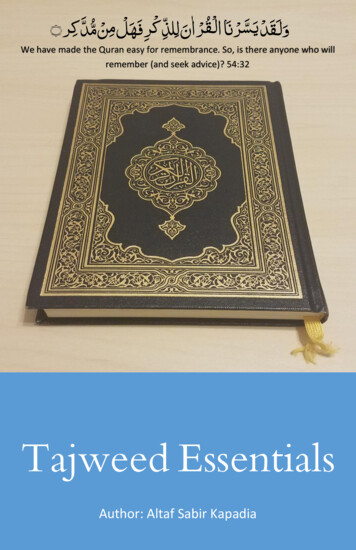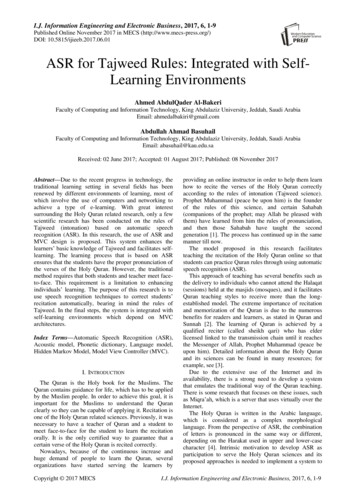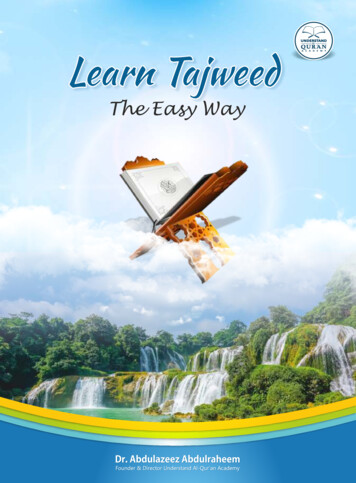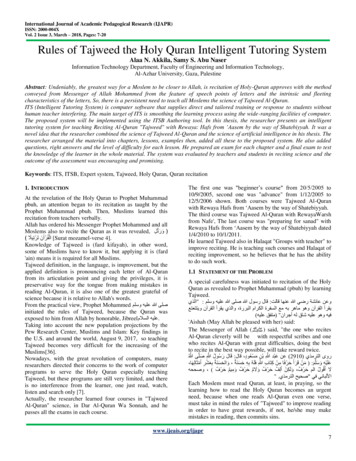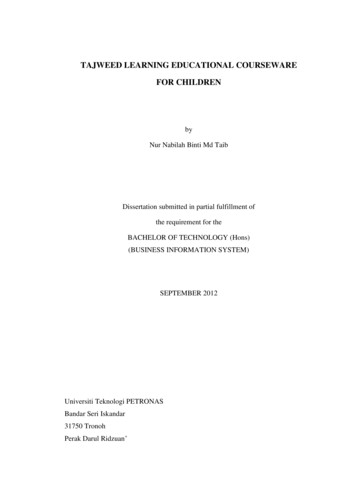
Transcription
TAJWEED LEARNING EDUCATIONAL COURSEWAREFOR CHILDRENbyNur Nabilah Binti Md TaibDissertation submitted in partial fulfillment ofthe requirement for theBACHELOR OF TECHNOLOGY (Hons)(BUSINESS INFORMATION SYSTEM)SEPTEMBER 2012Universiti Teknologi PETRONASBandar Seri Iskandar31750 TronohPerak Darul Ridzuan’
CERTIFICATION OF APPROVALTajweed Learning Educational Courseware for ChildrenbyNur Nabilah binti Md TaibA project dissertation submitted to theComputer and Information Science ProgrammeUniversiti Teknologi PETRONASin partial fulfilment of the requirements for theBACHELOR OF TECHNOLOGY (Hons)(BUSINESS INFORMATION SYSTEM)Approved by,(MS AINOL RAHMAH SHAZI BT SHAARANI)UNIVERSITI TEKNOLOGI PETRONASTRONOH, PERAKSEPTEMBER 2012
CERTIFICATION OF ORIGINALITYThis is to certify that I am responsible for the work submitted in this project, that theoriginal work is my own except as specified in the references and acknowledgements,and that the original work contained herein have not been undertaken or done byunspecified sources or persons.NUR NABILAH BINTI MD TAIB
ABSTRACTIt is compulsory for every Muslim to pray fives time a day as it is second pillar ofIslam. In fact, children also have to pray as early as ten years old. Thus, parentsshould ensure that their children are able to pray with correct pronunciation of prayerrecitation. Prayer recitation should pronounce correctly with its stipulated attributescalled Tajweed. However, a research conducted found many children has problem inrule of Tajweed. The survey result proves that many of students and children hasproblem in Tajweed rule either in pronunciation or the meaning of each rule. Also,children dislike learning facts and theory therefore by using multimedia and graphictutorial approaches; it might enhance the level of excitement to learn and the alsolevel of understanding on Tajweed rule. Thus, the project is aims to develop acourseware for children age five to twelve years old with the integration ofobjectivism teaching theory and multimedia elements. In addition, in order tovisualize the pronunciation to the users, the 2D approach will be used to make thepronunciation clear compared to lesson in classroom. The scope of the project is onlycovered Introduction to Tajweed, Hijaiyah letter and Nun and Tanwin classes. Thesystem is being developed by using all information gathered from surveys, interviewsand researches. Bahasa Melayu is chosen to be the intermediate language in thecourseware. The Instructional System Design methodology is been chosen to developthe courseware.
ACKNOWLEDGEMENTAlhamdulillah, thousands of gratefulness upon the Almighty ALLAH S.W.T for themany opportunities gained in life. However, a number of personnel author would alsolike to thank for the help and guidance throughout this two semesters.First and foremost, the author would like to convey the most sincere gratitude towardsMiss Ainol Rahmah Shazi bt Shaarani as the supervisor from Computer InformationSciences Department, for her valuable guidance and wisdom given throughout thissemesters. Interaction and opinion shared has helped the author to be morecomprehensive and gain knowledge towards making the learning process moremeaningful.Last but not least, the author would also like to thank to family members and friendswho have contributed towards the accomplishment of this project.
TABLE OF CONTENTSABSTRACT .iv.v.viINTRODUCTION.11.1.Background.11.2.Problem Statement.21.3.Objectives.31.4.Scope of Study.31.5The Relevancy of the Project .31.6The Feasibility of the Project .4ACKNOWLEDGEMENT .TABLE OF CONTENTSCHAPTER 1:CHAPTER 2:.LITERATURE REVIEW .52.1Introduction. .52.2Tajweed.52.3Introduction to Multimedia.62.4Courseware.72.5Children Education.92.6Conclusion.10.
CHAPTER 3:METHODOLOGY .123.1Project Activities.123.2Requirement .123.2.1Developer Requirement.123.2.2User Requirement.133.3Instructional System Design .133.4Gantt Chart.17RESULTS AND DISCUSSIONS.184.1Data Collection.184.2Research and Observation.184.2.1. Rule of 264.6Storyboard.284.7Usability Testing.38CONCLUSION AND RECOMMENDATIONS .395.1Conclusion and HAPTER 4:CHAPTER 5:SurveyTechnical Report.
LIST OF ILLUSTRATIONSLIST OF FIGURESFigure 1:ADDIE model of ISD14Figure 2:Status of Respondent21Figure 3:Channels use to gain Islamic Knowledge21Figure 4:Percentage of the awareness on the importance of Tajweed rule22Figure 5:Level of understanding on rule of Tajweed22Figure 6:Main causes of less understanding on rule of Tajweed for children 23Figure 7:Flowchart of Tajweed Learning Courseware26Figure 8:Homepage28Figure 9:Main Menu29Figure 10:Introduction to Tajweed30Figure 11:Pronunciation Demo31Figure 12:Menus for Tanween and Nun Sakinah32Figure 13:Outline for Tutorial33Figure 14:Example of Tutorial 134Figure 15:Example of Tutorial 234Figure 16:Example of Tutorial 335Figure 17:Option for user36Figure 18:Introduction for Simple Game37Figure 19:Game Platform37
LIST OF TABLESTable 1:Instructional Design complements Operational Capability8Table 2:Major rule of Tajweed19Table 3:Interview Report of Experts25Table 4:Testing Report38
CHAPTER ONEINTRODUCTION1.1Background of StudyIt is an obligation for Muslims to pray five times a day. At early age of ten, itis a must for the children to pray otherwise they will be punished. In the Holy Quran(4:103), Allah says “When ye have performed the act of worship, remember Allah,standing, sitting and reclining. And when ye are in safety, observe proper worship.Worship at fixed times hath been enjoined on the believers.” Daily prayers is thesecond pillars of Islam which Islamically defined to worship Allah through certainknown and prescribed saying and actions starting with Takbeer (saying AllahuAkbar) and ending with Tasleem ( saying as-salaamu’alaykum wa Rahmatul-lahiwabarakaatuh). Muslims must learn the proper way to pray, the rules and also theprayer recitation since children. The recitation should be pronounced correctly as it isone of the principles in a prayer. In addition, wrong pronunciation leads to differentmeaning of recitation. Therefore, Muslims need to learn proper way to pronounceevery letter in Holy Quran correctly with its stipulated attributes called Tajweed.According to Surur Shihabuddin Hassan An-Nadawi al-Hafiz (2010) in inhis book, Ilmu Tajwid Jilid I, tajweed is defined as knowledge on how to pronounceHoly Quran letter in a proper way. Allah says in Holy Quran (73:4) “Or add (a little)thereto - and chant the Qur’an in measure,” which mean Allah ask ProphetMuhammad to recite Holy Quran with Tartil (proper way, rule of Tajweed). Muslimmust first learn the basic knowledge of Tajweed which is Hijayah letter with itspronunciation. The rules of Tajweed can be classified into ten classes which arewaqaf, hamzah,qalqalah, nun and tanwin, nun and mim, mim sukun,lam sukun, lamta’rif, sukun, tafkhim and tarqiq, and mad. This project will only cover nun andtanwin class.Current method to learn tajweed such as books, television, classroom andradios are not attractive enough for children to learn Tajweed consistent. Nowadays,children are more attracted to technology based application such as animation games.1
Thus, integration objectivism theory and multimedia presentation might help childrento understand Tajweed in an effective way. The use of multimedia elements likeanimation, sound, graphic and video might make the learning process effective tochildren and make the learning much more fun.1.2Problem StatementHoly Quran acts as guidance in Muslim’s life. It is an indication of anyaction, words or habits to become a good khalifah on this world. Therefore, Muslimsshould read Holy Quran and follow what is prescribed in the Holy Quran. ReadingHoly Quran in a proper way is claimed in Islam. Even though learning Tajweed isfardhu kifayah for Muslims but reading Holy Quran in a proper way is fardhu ain.Hence, knowledge of Tajweed should be learned since childhood. At the moment,parents are aware on the importance of Holy Quran in their children’s life. However,there are many children have problems to read Holy Quran in a proper way inMalaysia.According to research done by Mustapha Kamil Che’Pa (2001), manystudent have problem in pronunciation and rules of tajweed. They have lessunderstanding on how to pronounce the letters with its attributes. Therefore, readingwith wrong pronunciation will affect the meaning given in Holy Quran which led tofalse understanding. Thus, does not matter where you live, Tajweed rule is veryimportant in Muslims’ life.The current learning methods such as books, radios, television and classroomfor children are efficient for a better reading but not effective to improve thepronunciation and understanding. Most of these method focus on one waycommunication which the users cannot interact with the system. The system use dullinterfaces and plenty of text approaches which makes children bored and hard tomemorize. There are also online applications in the Internet which provide soundsand video. However, these applications are more suited for adults because of theiruse of high level English and absent of multimedia element.As a result, this project called Tajweed Learning Educational Courseware isdeveloped to integrate Objectivism Teaching Theory and multimedia elements inorder to help Muslim children in learning Tajweed. The interactive design of2
interface, two way system, and multimedia elements used to develop the courseware.This approach aims to attract children to learn and enable them to interact to thesystem.1.3Objective1. To develop an interactive courseware of Tajweed Learning for childrenrange five totwelve years old which more effective and efficient.2. To integrate the Objectivism teaching theory and multimedia elements inthe courseware.1.4Scope of StudyThe scope of this project is focuses on Introduction of Tajweed, Hijaiyahletter and Nun and Tanwin class which comprise of Iqlab and Izhar Halqi.1.5Project RelevancyThis project aims to help children or Muslim society in improving theirTajweed. The target age of children is between five to twelve years old. This projectalso aims to be a kit for parents and teachers in teaching rule of Tajweed to theirchildren.Government provides many kinds of Islamic education as early as childrenschool. As example, an Islamic school provide from basis Islamic information untilintermediate level of information to the children. In Johor, it is a compulsory forchildren to attend an Islamic school. Thus, children have opportunity to learnTajweed early from their classroom. However, the teaching approach used inclassroom is one-to-many approach. Practically, it is not efficient in learningTajweed. This is because a teacher has to ensure every student pronounce the rightpronunciation for every letter or rules. With twenty and above students and in one ortwo hour class, it is impossible for teachers to check every student pronunciation. Asa result, up to thirty percent of student still do not understand each rules of Tajweedand lead to wrong pronunciation. Hence, the existence of this courseware in marketmay open the opportunity for them to learn Tajweed.3
With that limitation, parents also may use this courseware as a kit to teachtheir children Tajweed rule at home. Besides parents, teachers also might use thiscourseware as teaching kit in classes. Thus, by developing this courseware, it mighthelp and indirectly compliment their knowledge for a better understanding.1.6Time FeasibilityThe project is expected to due somewhere in December 2012. The duration ofthe project completion will be seven months starting from the project initiation onsecond week of May 2012. The project has 5 different phases which are analysis,design, development, implementation and evaluation. Currently, the project is stillunder development process. The project is planning to be implemented by earlyDecember 2012.4
CHAPTER TWOLITERATURE REVIEW2.1IntroductionRule of Tajweed is essential for every Muslim for reciting Holy Quranin a proper way. Tajweed is the correct way in pronouncing the Arabic letter with itscorrect attributes.There are several issues in learning Tajweed for Muslim. Someexamples included limited time to learn this knowledge from expert or teachers inschool, less medium to enhance the understanding of Tajweed, lack of awareness andothers. In the present paper, the new approach for teaching and learning Tajweed isinvestigated. It is hypothesized that, multimedia and courseware approaches willleads to higher level of understanding of theory and also practically. The followingfive literature review attempts to decent rate and support the hypothesis.2.2TajweedTajweed linguistically is to improve and make better. The technical definitionis the correct recitation of the Qur’an that is achieved by giving each letter its duethrough the vowel movement (Harakaat), prescribed point of exit (Makhraj) and themanner of articulation (Sifa) (Muhammad Fathi, 2012).According to Ad-Durrul Mukhtar, Mazhab Hanafi and most of ScholarSyafie have a certain view that reciting Holy Quran with wrong pronunciation inprayer is completely not accepted. However, if he repeats and corrects thepronunciation, then the prayer will be accepted. Imam ibn Al-Jazari, one of theearliest scholars of Tajwid, maintained in his Tufatul-Atfal, a famous beginner styleTajwid manual, that it is incumbent to observe the rules of Tajwid, those who fail todo so are incurring a sin because the Holy Quran was revealed by Allah andtransmitted to us with the rules of Tajwid ( Muhammad Fathi, 2012).In a research article by Rohaya (2005), she investigated on the application ofObjectivism concept in teaching Rule of Tajweed to Muslims. Objectivism conceptemphasizing that fact is facts, which cannot be altered simply. The concept is5
integrated with multimedia elements in order to enhance the understanding of theusers. The surveys are conducted at bookstores and through Internet to approve thehypothesis. This project has excellent objectives in enhance the users understandingby using specified teaching method. However, the limitations for this research aresample group of studies. This project is not specifying to specific group of age,meaning it is for general. The courseware might useful to certain level of age but notso efficient maybe for few level of age because no specification in term of targetmarket. This project only aims to create the ‘easy’ way to enhance usersunderstanding but then, the developer not focusing into one segment which is veryimportant in order to meet the user requirement. Other limitation is the researchmethodology for the project, survey which conducted in bookstore. Survey can beconducted everywhere, but as for the research observation; survey must be conductedin several places. Logically, people who come to the bookstore usually look forreading materials which are very helpful in gathering information. But somehow, thedeveloper has to expand the location and target respondent. These kind ofinformation is very helpful in develop a system which meets users requirement.Researchers found that students are not being able to pronounce correctly isbecause they have less understanding on how to pronounce. In class, most of thestudents are just repeating the pronunciation from their teachers and they are not surewhether they pronounce correctly or wrong. Thus, one to one approach like CDROM might helpful in order for them to learn and listen to the audio clips manytimes.2.3Introduction to MultimediaMultimedia is presenting words such as printed text or spoken text andpictures such illustrations, photos, animation or videos (Mayer, 2005). He claimedthe wording material in multimedia is presented in verbal form such as using printedtext. On the other hand, picture is presented in pictorial form such as using static ordynamic graphic. Thus, information is being present in an attractive way to the user.Referring to Hofstetter (2001), multimedia is the use of computer to presentand combine text, graphic, audio, and video with links and tools that let the usernavigate, interact, create and communicate. It means the integration of multimediaelements in a system enable the user to interact with by using the computer.6
According to I.T.L Education Solution Limited (2009), word multimedia ismade up of two separate word, multi meaning many and media meaning materialsthrough which information may be transmitted. Therefore, multimedia can be definedas technique that supports the physical and logical coexistence and interactive use ofheterogeneous media classes such as print, audio and video in specific applicationenvironment.Using video, audio and CD-ROM to deliver information is most effectiveway than through paper based and face to face communication. The multimediaapplication is actually creating hybrid pedagogy which utilizes technology. Theusage of Multimedia technology is actually widely used in teaching to enhance thelearning environment. (Kachian & Wieser, 1999)In this era globalization, multimedia is widely use in most of the industryinclude education.Steinmetz and Nahrstedt (2004) analysed there are stronginterest in existing multimedia system in various sector such as telecommunicationindustry, electronic industry, TV and radio broadcasting and also in education. Theeffects of multimedia system on people are grouped into knowledge transfer,entertainment, and data processing. Multimedia paradigm, the dominant convictionamong multimedia system developed and users that adding multimedia functionalityto information systems always leads to improved information and knowledge transfer(Martijn, 1997).2.4CoursewareAccording to whatis.com (2008), courseware is an educational materialintended as kits for teacher or tutorial for students, usually packaged for use with acomputer. The most common knowledge area encompass in courseware isinformation technology.Courseware learning supports individual learning with consideration of thedifferent of individual. Courseware provides Learner initiated learning. While theinstructor chooses the content and gives a lecture to learners on a massive scalethrough his own intentions in classical learning, the learner can choose the contentand can study at his learning pace, at his level and according to his interest in7
Courseware learning. Courseware provides self-directed, self-paced learning, andlearning based on various media.The developer of courseware has to ensure the users of multimedia elementsare not overshadow the text element which is the main ingredient for learning. Aresearch conducted by specialist of Multimedia Design, Schitai (1998) shows thatmajority of the courseware programs include information, computation andmultimedia components by making use of the computer’s operational capabilities,however instructional design considerations need to be applied to each one of thesecomponents to ensure learning has indeed occurred. The table below describes howinstructional design principles can complement the operational capabilities ofcomputers:Operational CapabilityInstructional Design Link To LearningInformation DeliveryDesign information strategiesPerformance ComputationProvide individualized feedbackMultimediaDefine media combinations and interactivity levelTable 1: Instructional Design complement Operational Capability ( Schitai,1998)Courseware benefits through simulation learning, it supports learningactivities that cannot be accessed in classical learning due to limitations, cost anddanger. In addition, it allows the learner to repeatedly practice the things that helearns. In classical learning the teacher has limitation in giving a lecture repeatedly,but courseware learning allows the learner to repeat the lecture and practices as manytimes as is necessary. Furthermore, it makes learning interesting by combining thecontent with games and activities. This is especially useful for children. Otherresearchers conducted in few studies found that courseware produces positive effectsin logical learning such as mathematics and science subjects. Multimedia learning iseffective by supporting multi-sensory learning (Heinich et al. 1996). Learning is bestfacilitated through combination of complementary visual and auditory information(Mayer, 2005). Multimedia learning produces positives result in foreign languagelearning. However, courseware design should adapt to the learners’ skill andknowledge.8
Alessi and Trollip (1991) list down ten step of courseware developmentprocess. In order to develop a courseware, firstly, the developers need to determinegoal for a single lesson. The users should understand what they learned throughoutthe end of the lessons. Second step is searching for resource materials include books,journal, films, substitute products or survey. Resource materials are group intoresources materials for instructional design and for delivery system. The computer,operation manual and references guide are the example of resource materials fordelivery system. Step three is to learn the content. The developer should learn thecontent as familiar with the users’ environment or challenges will be helpful indesigning the interfaces and delivering the information. The developers must havedeep knowledge and understanding on users’ behaviour, problems and requirement todevelop a high-quality courseware. After learning the content, the developers have tobrainstorm to generate creative ideas with the assistance from experts or others. Nextstep is designing the instruction from brainstorming outcome. The ideas may vary interm of the quality. Thus, the developer should filter and re-list the ideas according tousers’ priority. Afterwards, describe the flow of system or learning in a flowchart.The flowchart is important to visualize the presentation especially to computer basedinstruction because of the iterative process. While flowchart depict the sequence of alesson, storyboard take place the process of preparing textual and images display in alesson. The storyboard is needed to understand the whole presentation of the lessons.After drafting and designing the ideas on papers, the developers have to convert theideas into programmable software. The software might be Flash, Macromedia, orany multimedia software to develop the application. It is advisable to have somesupporting materials for computer based instruction. The technical manuals andusers’ guideline are the example of supporting materials. Finally, the lesson andsupport materials should be evaluated by experts and target users.2.5Children EducationA child is a fast learner compared to an adult especially during early age ofsix. They learned from the surrounding environment. According to Graham (2008),based from survey conducted, there are three basic learning styles for children whichare auditory, kinaesthetic and visual learner. Auditory learners prefer listening toexplanation over reading and may like to study by reciting the information aloud.They might want to have background music while studying or quiet space or maybe9
distracted by noises. On the other hand, kinaesthetic learners learn by doing andtouching. They prefer writing down the information or doing hands-on activitiesrather than sitting while studying. Children who choose to look at graphics, watchinga demonstration or reading are in visual learners group. They can easily graspinformation presented in a chart or graph.Montessori Philosophy stated there are three stages of learning for childrenage three to twelve years old. First stage is introduction to a concept by means of alecture, lesson, something read in a book or sources of information. Then, processingthe information, developing an understanding of the concept through work,experimentation, and creation will occur in second stage. Last stage of learning“knows”, to possessing an understanding of, demonstrated by the ability to pass a testwith confidence, to teach another or to express with ease (Stephenson, 2011).Children are more attracted to image, sounds, colour, graphic rather than text.It will be easier for them to memorize information. In addition, children also aremore appealed to computer based learning than reading books. Classroom occupiedwith computers is actually improving the confidence level of children. This isbecause children become more competent in a classroom and they pretend to be anadult. Computer based learning also attract children to learn and improve thecreativity skill in solving problems (Cohen, Cowan 2007).2.6ConclusionMultimedia is combination of text, sound, graphic and picture into anapplication for an interactive effect to attract the audience. The usage of multimediain an application create ‘live’ interface, user friendly and enables users to interactthroughout learning process. As an example, users can navigate from one chapter toanother without limitation. Users might turn off the background music or repeat thesame lesson many times as they wish.Multimedia is one of the components in a courseware. It provides selflearning based on various media. Even though, the information or lesson needs to behighlighted more than multimedia elements, it actually compliments each other. Thedelivery of information will be more attractive and interesting to the users in this10
project which are children with the combination of colourful text, background music,animation and graphic.Current method of teaching Tajweed through website, books and CD are notsuitable for children education. Website or online software in internet is complicatedfor children to grasp the knowledge. The interface and teaching approaches are morefocus on adult compare to children.On the other hand, books providecomprehensive information and theory which are too complex for them to memorize.Picture and color give more impact than lengthy text to the children.Children have three different basic learning styles. They might love listeningthan reading, picture than text and may 9be hate music background and choose tostay in a quite space to study. Courseware is a flexible learning tool that might suit alldifferent kind of children learning style. As an example, children who love listeningthan reading may play the sample pronunciation many times until they understandand being able to pronounce correctly rather than reading the theory. Imam AlGhazali pointed out that children learn from observation and experiment (MasturaBadzis, 2012). In addition, children play all the times except during sleeping. Hence,the storyboard of lesson in courseware is actually design according to users’ interest.Majority of courseware for children uses multimedia and game based learning tocater their attention. To ensure their understanding is being evaluated at the end oflesson, the assessment will be in game form.As a conclusion, the interactive design of courseware can make learningprocess more interesting to children. They may be able to memorize and understandthe rule of Tajweed in a short time. The courseware will be available anywhere andwhenever they want to study. The courseware also can be used as revision tools andsupporting medium for parent to teach their children.11
CHAPTER 3RESEARCH METHODOLOGY3.1 PROJECT ACTIVITIESACTIVITIESConducting SurveysPURPOSETo observe and collect data from parents, teachers andstudent.InterviewsTo collect data from expert in Tajweed domain andfeedback from system testing.Multimedia ClassTo enhance basic skill in FLASH and ACTION SCRIPT3.0.3.2 REQUIREMENT3.2.1 Developer RequirementThe requirements needed for the developer to build this courseware are software andhardware requirement.The hardware requirements are:1. Pentium IV 1.62. 256 MB of RAM3. Hard Disk Drive 4Gb4. CDRW Drive5. SVGA Color Monitor6. Speaker12
The software requirements are:1. Macromedia Director MX 20042. Lightwave 3D version 8.03. Adobe Photoshop CS34. Macromedia Flash MX5. Microsoft Office6. Sound Recorder3.2.2 User RequirementThe hardware requirements needed for the user to use this courseware are:1. Pentium IV 1.62. 256 MB of RAM3. Hard Disk Drive4. CD/CDRW Drive5. SVGA Color Monitor6. Sound card connected to the speaker7. Display Card with at least 8MB of memoryThe software requirements needed for the user to use this courseware are:1. Flash Player 92. Arabic Fonts; Amien01 and Stnask3.3 Instructional System DesignThis project used Instructional System Design (ISD) as a methodology todevelop the courseware. Based from all research done, the best approaches for thisproject is by using courseware and multimedia elements in order to enhance the usersunderstanding.ISD is commonly used as a guideline to create a course, instructionalmaterials, programs, training session and product for educational program. Thismethod ensures the process of software development is design systematically, usingstep by step approach with specific measurable outcomes. The model for ISD is13
ADDIE which referring to Analysis, Design, Development, Implementation andEvaluation. These processes are sequential and interactive as shown in Figure NEVALUATIONFigure 1: ADDIE model of ISDAs in Figure 1, the iterative aspect is represented vertically down the model byarrows in both directions between each phase. On the left side of model, evaluationis accompanying each phase to test the adequacy of the decision and progress madeduring that phase. As an example, the precision of the instructional strategy or planfor the project after designing phase is evaluated by experts. The evaluation is takeplace after each phase.Phase 1: AnalysisAnalysis is the first stage of ADDIE model. Identification of
Holy Quran in a proper way is claimed in Islam. Even though learning Tajweed is fardhu kifayah for Muslims but reading Holy Quran in a proper way is fardhu ain. Hence, knowledge of Tajweed should be learned since childhood. At the moment, parents are aware on the importance of Holy Quran in their children's life. However,
